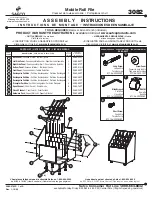
Chapter 4: Cell Connections--Normal Cell Connections
4 - 1
Chapter 4
:
Cell Connections
Normal Cell Connections
Each Interface 1000 in your system was shipped with a standard, shielded cell cable (part number 985-00071).
It is a 60 cm complex cable with a 25-pin D-type connector on one end and four banana plugs and two pin
jacks on the other end.
In some cases, your system may also include a special-purpose cell cable. The special purpose cell cable
includes documentation describing its use.
The 25-pin male end of the standard cell cable connects to the Interface 1000’s front panel
Cell Cable
connector.
Always affix the cell cable into place with the two screws, because this cable can fall off the unit. This can be
disastrous if it occurs during an experiment.
The other end of the cell cable terminates in a number of banana plugs and two pin jacks. Each termination
comes with a removable alligator clip. Table 4-1 identifies each terminal of the cable.
Table 4-1
Cell Cable Terminations - Potentiostat and Galvanostat Modes
Color
Type
Name
Normal Connection
Blue
Banana plug
Working Sense
Connect to working electrode
Green
Banana plug
Working Electrode
Connect to working electrode
White
Pin jack
Reference
Connect to reference electrode
Red
Banana plug
Counter Electrode
Connect to counter electrode
Orange
Banana plug
Counter Sense
Used in ZRA mode; connect to counter electrode
Black
Pin jack
Floating Ground
Leave open or connect to a Faraday shield
Connect both the blue and green cell leads to the working electrode. The working electrode is the specimen
being tested. The blue banana-plug connection senses the voltage of the working electrode. The green
working-electrode connection carries the cell current. The working electrode may be as much as 150 mV
above the circuitry ground (
Chassis Ground
).
Connect the white pin jack to the cell’s reference electrode, such as an SCE or Ag|AgCl reference electrode.
The measured cell potential is the potential difference between the blue and white cell connectors.
Connect the red banana plug to the counter or auxiliary electrode. The counter electrode is usually a large inert
metal or graphite electrode. The counter electrode terminal is the output of the Interface 1000 power
amplifier.
The orange lead is only used in ZRA mode, where it senses the counter-electrode potential (see following
section). Automatic switching to ZRA mode is possible if this lead is connected to the counter electrode. If you
are not using ZRA mode, leave this lead open as long as you ensure that it will not short against any other
electrode.
The black pin jack is connected on the Interface 1000 end to
Chassis Ground
. This is the circuitry ground for
the analog circuits in the Interface 1000. In most cases, leave this terminal disconnected at the cell end. When
you do so, take care that its metal contact does not touch any of the other cell connections.
Содержание Interface 1000
Страница 8: ......
Страница 18: ......
Страница 36: ...Chapter 4 Cell Connections Membrane Cell Connections 4 4...
Страница 44: ...Chapter 5 Panel Indicators and Connectors Rear Panel 5 8...
Страница 62: ...Chapter 8 Measurement of Small Signals Floating Operation 8 8...
Страница 68: ...Appendix A Interface 1000 Specifications Floating Operation Appendix A 6...
Страница 70: ...Appendix B Interface 1000 Cell Connector Floating Operation Appendix B 2...
Страница 78: ...Appendix E CE Certificate Appendix E 2 Low Voltage Certificate of Conformance...
Страница 79: ...Appendix E CE Certificate Appendix E 3 RFI Certificate of Conformance...
Страница 80: ...Appendix E CE Certificate Appendix E 4...
Страница 84: ...Appendix F Heat in Interface 1000 MultEchem Systems Appendix F 4...
















































